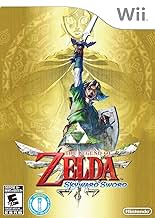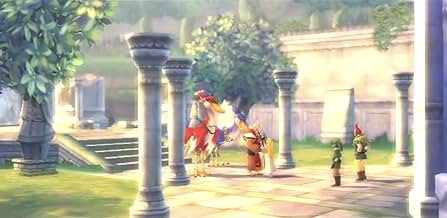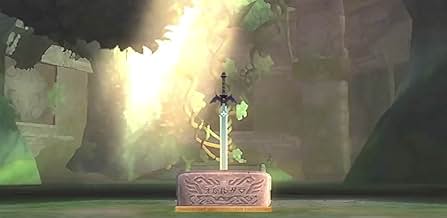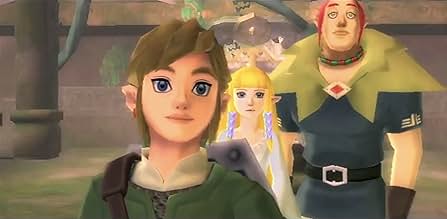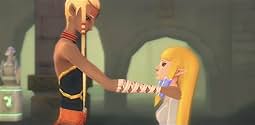The Legend of Zelda: Skyward Sword
Titre original : Zeruda no densetsu: Sukaiwôdo sôdo
NOTE IMDb
8,2/10
2,7 k
MA NOTE
Ajouter une intrigue dans votre langueBorn on an island suspended in the sky, a young man, Link, accepts his destiny to venture to the world below to save his childhood friend, Zelda, and the land from evil forces through the us... Tout lireBorn on an island suspended in the sky, a young man, Link, accepts his destiny to venture to the world below to save his childhood friend, Zelda, and the land from evil forces through the use of a mysterious sword.Born on an island suspended in the sky, a young man, Link, accepts his destiny to venture to the world below to save his childhood friend, Zelda, and the land from evil forces through the use of a mysterious sword.
- Nomination aux 2 BAFTA Awards
- 3 victoires et 11 nominations au total
Takashi Ôhara
- Link
- (voix)
- (as Takashi Oohara)
Ayumi Fujimura
- Fi
- (voix)
Yû Shimamura
- Zelda
- (voix)
- (as Yu Shimamura)
Anri Katsu
- Ghirahim
- (voix)
Kenji Takahashi
- Groose
- (voix)
Rei Shimoda
- Impa
- (voix)
Takashi Nagasako
- Demise
- (voix)
- (non crédité)
Histoire
Le saviez-vous
- AnecdotesThis is one of the first games created to look like a painting. The art was inspired by impressionistic painters, particularly Cezanne.
- GaffesSome objects fly using a single rotor to stay aloft. Nothing can fly with less than 2 rotors.
- ConnexionsFeatured in ScrewAttack's Top 10s: Top 10 Wins and Fails of E3 2010 (2010)
Commentaire à la une
(www.plasticpals.com) Nintendo returns to the Legend of Zelda series once again with Skyward Sword, but they've managed to create a fairly unique world for the game, with childhood friends Link and Zelda living in the floating island town called Skyloft. The game begins as Link is about to compete in an annual competition to see who will become the town's next knight.
Being that this is the first Zelda title built from the ground up for the Wii (Twilight Princess was initially developed for the Gamecube), Nintendo really tried to get the most out of the Wii's motion controls. They ended up going with the enhanced functionality of the Wii Motion Plus, which is better able to track the orientation of the remote.
There are a slew of new and returning items to use, and most of them take advantage of the Wii remote's functionality. The designers even managed to find a new way to use bombs (you can now roll them on the ground like a bowling ball), which is great to see after all these years. It's one of the few Wii games where the motion controls feel tightly integrated with the game play.
New Ideas: Critics have begun to question if the Zelda series needs to evolve, and in response there are a couple of new concepts introduced which are a step in the right direction. The biggest addition is the stamina system, which allows Link to sprint for a few seconds. You can now sprint towards a wall and Link will jump up and grab onto a ledge if one exists. He can also overcome small obstacles by hopping over them. Stamina can also be used to quickly maneuver while climbing. It's a great addition that really helps take some of the monotony out of normal actions.
Another new concept is the upgrade system, which allows you to trade in loot to enhance equipment. Loot comes in many forms, from the insects you collect with a bug-catching net to rare trinkets found throughout the world. It's a decent system, but it does mean there are fewer mini-games to be played (where Link would normally acquire item upgrades). I'm not sure the trade-off is worth it, but if the system could be refined or applied only to certain types of equipment in future games it could really benefit the series. You can also infuse potions with insects to create more powerful effects, which is another good idea, and any excess loot can be traded for rupees if you're short on cash. However, the constant sub-screen prompts when you pick up an item – once per item per game session – is very annoying.
By far one of the best new ideas in Skyward Sword are the time crystals, which dynamically alter the world around them when activated. These crystals are only found in one of the game's major areas but makes for some of the most inventive puzzles and game play situations. It would be a shame if this sort of thing didn't make another appearance in future titles. Less exciting are the underground passages which Link can dig into. Here the game switches to an overhead view of Link crawling through a maze of tunnels.
Not so great is the new storage system, which is only useful because Link has a limited number of item pouches. Even when you've got the full eight item pouches you won't have room to store everything you'd like to carry at once (larger quiver, bomb bag, slingshot ammo, bottles, etc.). It means you'll have to compromise on what extras you carry, which I suppose adds to the game's difficulty slightly, but if that is its only purpose than it is slightly annoying. Related to this are the wallets, which come in various sizes and can only store a certain number of rupees – it's one of those elements which has hung around since the N64 days designed to limit you from buying items up too quickly.
Presentation: As with The Windwaker, Skyward Sword is set apart with a unique visual effect, though this time it is a bit more subtle. A depth of field effect dissolves the background into paint splotches, which succeeds in giving the graphics an impressionistic feel. Although it is just a filter effect, it can create some picturesque vistas. This is also the first Zelda title with an orchestral score, which is a major step for the franchise. However the lack of voice overs, which leaves the characters silently miming their dialogue during the many story sequences, detracts from the presentation. It may be time to include optional voice-overs.
One of the problems I have with Skyward Sword's art direction are the monster and creature designs. While the bosses are generally quite cool looking, the majority of the monsters (and friendly creatures) introduced in the game are a bit wonky. It feels half way between the style of The Windwaker and that of Twilight Princess, and falls short of both. And the game lacks the dynamic time and weather effects of earlier games, which is disappointing. At least they let you choose from a number of HUD options, preventing the regular HUD from cluttering the screen.
Conclusion: The Legend of Zelda Skyward Sword is another excellent chapter in this long-running and much beloved series, and introduces some new ideas and game play concepts to keep things from becoming stale. It offers around 35 to 40 hours of questing and has an optional "Hero" mode for those seeking a greater difficulty. The new Wii-motion Plus controls add to the experience and the painterly visuals and symphonic score round out the package. It's not a perfect game, but the issues are relatively minor ones, so it's an easy recommendation.
Being that this is the first Zelda title built from the ground up for the Wii (Twilight Princess was initially developed for the Gamecube), Nintendo really tried to get the most out of the Wii's motion controls. They ended up going with the enhanced functionality of the Wii Motion Plus, which is better able to track the orientation of the remote.
There are a slew of new and returning items to use, and most of them take advantage of the Wii remote's functionality. The designers even managed to find a new way to use bombs (you can now roll them on the ground like a bowling ball), which is great to see after all these years. It's one of the few Wii games where the motion controls feel tightly integrated with the game play.
New Ideas: Critics have begun to question if the Zelda series needs to evolve, and in response there are a couple of new concepts introduced which are a step in the right direction. The biggest addition is the stamina system, which allows Link to sprint for a few seconds. You can now sprint towards a wall and Link will jump up and grab onto a ledge if one exists. He can also overcome small obstacles by hopping over them. Stamina can also be used to quickly maneuver while climbing. It's a great addition that really helps take some of the monotony out of normal actions.
Another new concept is the upgrade system, which allows you to trade in loot to enhance equipment. Loot comes in many forms, from the insects you collect with a bug-catching net to rare trinkets found throughout the world. It's a decent system, but it does mean there are fewer mini-games to be played (where Link would normally acquire item upgrades). I'm not sure the trade-off is worth it, but if the system could be refined or applied only to certain types of equipment in future games it could really benefit the series. You can also infuse potions with insects to create more powerful effects, which is another good idea, and any excess loot can be traded for rupees if you're short on cash. However, the constant sub-screen prompts when you pick up an item – once per item per game session – is very annoying.
By far one of the best new ideas in Skyward Sword are the time crystals, which dynamically alter the world around them when activated. These crystals are only found in one of the game's major areas but makes for some of the most inventive puzzles and game play situations. It would be a shame if this sort of thing didn't make another appearance in future titles. Less exciting are the underground passages which Link can dig into. Here the game switches to an overhead view of Link crawling through a maze of tunnels.
Not so great is the new storage system, which is only useful because Link has a limited number of item pouches. Even when you've got the full eight item pouches you won't have room to store everything you'd like to carry at once (larger quiver, bomb bag, slingshot ammo, bottles, etc.). It means you'll have to compromise on what extras you carry, which I suppose adds to the game's difficulty slightly, but if that is its only purpose than it is slightly annoying. Related to this are the wallets, which come in various sizes and can only store a certain number of rupees – it's one of those elements which has hung around since the N64 days designed to limit you from buying items up too quickly.
Presentation: As with The Windwaker, Skyward Sword is set apart with a unique visual effect, though this time it is a bit more subtle. A depth of field effect dissolves the background into paint splotches, which succeeds in giving the graphics an impressionistic feel. Although it is just a filter effect, it can create some picturesque vistas. This is also the first Zelda title with an orchestral score, which is a major step for the franchise. However the lack of voice overs, which leaves the characters silently miming their dialogue during the many story sequences, detracts from the presentation. It may be time to include optional voice-overs.
One of the problems I have with Skyward Sword's art direction are the monster and creature designs. While the bosses are generally quite cool looking, the majority of the monsters (and friendly creatures) introduced in the game are a bit wonky. It feels half way between the style of The Windwaker and that of Twilight Princess, and falls short of both. And the game lacks the dynamic time and weather effects of earlier games, which is disappointing. At least they let you choose from a number of HUD options, preventing the regular HUD from cluttering the screen.
Conclusion: The Legend of Zelda Skyward Sword is another excellent chapter in this long-running and much beloved series, and introduces some new ideas and game play concepts to keep things from becoming stale. It offers around 35 to 40 hours of questing and has an optional "Hero" mode for those seeking a greater difficulty. The new Wii-motion Plus controls add to the experience and the painterly visuals and symphonic score round out the package. It's not a perfect game, but the issues are relatively minor ones, so it's an easy recommendation.
- robotbling
- 24 nov. 2012
- Permalien
Meilleurs choix
Connectez-vous pour évaluer et suivre la liste de favoris afin de recevoir des recommandations personnalisées
Détails
- Date de sortie
- Pays d’origine
- Sites officiels
- Langues
- Aussi connu sous le nom de
- ゼルダの伝説 スカイウォードソード
- Sociétés de production
- Voir plus de crédits d'entreprise sur IMDbPro
- Couleur
- Rapport de forme
- 1.78 : 1
Contribuer à cette page
Suggérer une modification ou ajouter du contenu manquant







